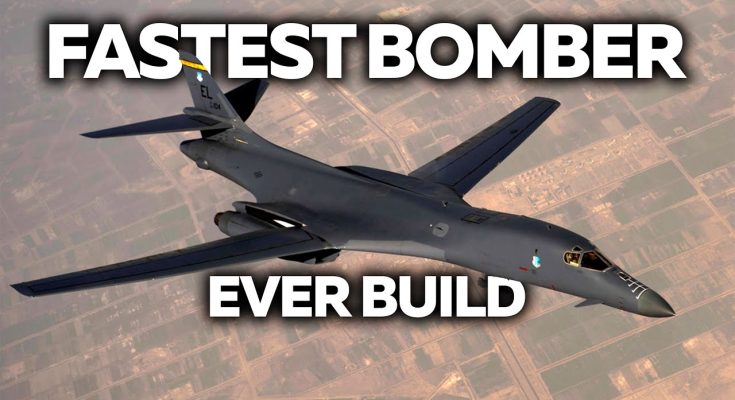The B-1B Lancer, often referred to as the “Bone,” has earned a reputation as one of the most feared bombers in the world. Its sheer speed, versatility, and firepower make it a formidable asset in the U.S. Air Force’s arsenal. While it was originally designed as a high-speed, nuclear-capable bomber during the Cold War, its continued evolution and capability upgrades have made the B-1B a key player in modern warfare. Today, the Lancer remains one of the most lethal and adaptable aircraft ever built, earning the respect—and fear—of adversaries worldwide.
Unmatched Speed and Versatility
One of the key attributes that has made the B-1B so feared is its speed and versatility. With a top speed of Mach 1.25, the B-1B can fly at supersonic speeds, outpacing most other bombers and offering a rapid response time in combat scenarios. This allows the Lancer to quickly reach targets far from home bases, while also evading detection and interception by enemy forces. Its sleek design and variable-sweep wings provide high-speed performance without sacrificing maneuverability at lower speeds.
But speed is just one aspect of the B-1B’s capability. The bomber’s adaptability is what truly sets it apart. While originally intended as a nuclear bomber, it has undergone numerous upgrades over the years to carry out conventional bombing missions as well. It can now deploy a wide range of munitions, including precision-guided bombs, cruise missiles, and other advanced weaponry. This makes the B-1B suitable for a variety of missions, from striking high-value targets to providing close air support in ground operations.
Precision and Firepower
The B-1B’s ability to carry a massive payload of up to 75,000 pounds of ordnance further solidifies its status as a fearsome bomber. Its large bomb bay and ability to carry a diverse array of weapons give it the flexibility to perform a wide range of combat operations. The Lancer can carry everything from conventional bombs to advanced guided missiles like the Joint Direct Attack Munition (JDAM) and the Joint Air-to-Surface Standoff Missile (JASSM).
In addition to its vast payload capacity, the B-1B is equipped with sophisticated targeting systems and avionics, which allow it to strike with pinpoint accuracy. Its radar and navigation systems allow it to conduct “low-level penetration” missions, flying at extremely low altitudes to avoid enemy radar detection. These capabilities, combined with its weapon systems, make the B-1B an extremely potent tool for both strategic and tactical bombing missions.
Stealth and Evasion Capabilities
While not a stealth bomber like the B-2 Spirit, the B-1B has impressive evasion capabilities, especially in contested environments. The bomber’s ability to fly at low altitudes allows it to avoid detection by ground-based radar and enemy fighters. Its radar cross-section has been minimized through various design elements, making it harder to detect than larger, non-stealth aircraft.
Additionally, the B-1B has been equipped with advanced electronic warfare (EW) systems designed to jam or disrupt enemy radar and communications systems. These EW systems enhance the bomber’s survivability in contested airspaces, allowing it to operate in high-threat environments without being easily targeted by enemy air defenses. These features are particularly important in modern warfare, where sophisticated radar and missile defense systems pose a significant threat to traditional bombers.
Combat Experience and Reputation
The B-1B Lancer has proven its effectiveness in combat over several decades. It has been involved in numerous conflicts, including the Gulf War, Operation Enduring Freedom, and Operation Iraqi Freedom. During these operations, the B-1B demonstrated its ability to deliver precise, devastating strikes on enemy targets while operating in complex and hostile environments. Its ability to rapidly deploy and strike at long distances has made it a crucial asset in both conventional and nuclear operations.
The B-1B’s combat success, combined with its fearsome capabilities, has contributed to its reputation as one of the most lethal bombers in the world. Its combination of speed, firepower, precision, and survivability makes it a critical component of U.S. military strategy, instilling fear in potential adversaries who know that the “Bone” can strike quickly and with deadly force.
The Future of the B-1B
Despite the emergence of newer, stealthier bombers like the B-2 Spirit and the upcoming B-21 Raider, the B-1B remains a critical part of the U.S. bomber fleet. With ongoing upgrades to its avionics, weapons systems, and electronic warfare capabilities, the B-1B will continue to be a formidable force for years to come. While it may not be as stealthy as its counterparts, its speed, firepower, and adaptability ensure that it will remain one of the most feared bombers in the world.
In conclusion, the B-1B Lancer is not just another bomber—it is a symbol of the U.S. Air Force’s ability to project power and strike fear into adversaries. Its unmatched combination of speed, firepower, and versatility makes it a true force to be reckoned with in the skies, and its legacy as one of the most feared bombers ever built is assured.



